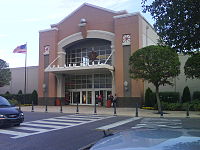- Bel Air Mall
-
Coordinates: 30°40′28.59″N 88°7′23.3″W / 30.6746083°N 88.123139°W
Bel Air Mall
Bel Air Mall is one of the largest enclosed malls along the Gulf CoastLocation Mobile, Alabama Opening date August 16, 1967 Developer Kenneth R. Giddens, William Lyon and Jay Altmayer Management Jones Lang LaSalle Owner Jones Lang LaSalle No. of stores and services 130 No. of anchor tenants 5 No. of floors 1, Dillard's, JCPenney and Sears all feature 2 levels Website Bel Air Mall Bel Air Mall is a super-regional shopping mall, located in Mobile, Alabama, United States. The mall has a gross leasable area of 1,345,000 square feet (125,000 m²).[1] It is the oldest continuously operating enclosed super-regional mall in Alabama[2] and serves as one of the primary retail venues for the west Mobile shopping district located at the vicinity of Airport Boulevard and Interstate 65. Currently, Belk, Dillard's, JCPenney, Sears and Target serve as the mall's anchor stores; the mall also features more than 130 stores and restaurants.
Contents
History
More than ten years of research and planning took place before Bel Air Mall finally came to fruition in August 1967. Designed by the architecture firm of Herbert H. Johnson Associates of Washington, DC, the enclosed mall was developed by WKRG-TV founder Kenneth R. Giddens, William Lyon and Jay Altmayer as the centerpiece of an automobile-centric edge city known as Bel Air. In its original configuration, the mall consisted of a one-level 900-foot (270 m) long retail corridor of fifty in-line tenants anchored by Sears and local department store chain Hammel's. Over the years, the mall would be complemented by extensive commercial developments in the form of movie theaters, communal strip malls, office complexes and upscale apartment complexes in surrounding Bel Air development sites.
Hammel's would become D. H. Holmes in 1973. D. H. Holmes, a New Orleans-based department store, subsequently added a second level to the building and transformed it into a 200,000-square-foot (19,000 m2) hub for its Gulf Coast operations.[3] In the mid-1970s, a 191,000-square-foot (17,700 m2) JCPenney store would serve as a two-level anchor for Bel Air Mall’s new north-south enclosed mall corridor. With the completion of this mall expansion project, Bel Air Mall became Alabama’s largest regional mall, a title it would retain until the 1986 debut of Riverchase Galleria in suburban Birmingham.
In February 1984, Parisian would serve as the 90,000-square-foot (8,400 m2) anchor of a 122,000-square-foot (11,300 m2) mall expansion just east of JCPenney.[4] Sporting a modern interpretation of French Colonial architectural style, this expansion included a food court featuring a sunken seating area, landscaping and water features, a Ruby Tuesday casual dining restaurant and several new in-line retailers. Its exterior entrance would be marked with a two-level structure, although the second level was inaccessible and essentially functionless. In 1989 Arkansas-based Dillard's would enter the South Alabama market, with the acquisition of the troubled D. H. Holmes chain.
Bel Air Mall began the 1990s with a $14 million dollar overhaul which updated the mall’s image. The signage was updated. The white modernist facades of the mall complex were enhanced with soft and warmer tones, the massive surface lots were extensively landscaped, and in the most noticeable design change, the two-tiered entrance structures which flanked the food court and main entrances were replaced with less dramatic canopied structures.
Bel Air Mall’s most dramatic expansion and renovation would occur in 1996. In March of that year, discount retailer Target announced it would be locating its first South Alabama store at the mall. This served as the catalyst for a $40 million dollar project that would see expansion and related renovation projects at the four other anchor stores. The food court and a couple of in-line merchants, including Bailey Banks and Biddle, were demolished for Target’s 116,000-square-foot (10,800 m2) debut. Sears would increase by 90,000 square feet (8,400 m2), including a new 70,000-square-foot (6,500 m2) second level and a more contemporary building facade. Parisian engulfed a mall corridor that previously connected the food court and the north-south mall in order to expand to 122,000 square feet (11,300 m2). Dillard's undertook a substantial interior and exterior renovation, while JCPenney made storewide changes.
The mall would become Colonial Mall Bel Air in the summer of 2000, following Colonial Properties acquisition of the mall in 1998. It would then revert back to Bel Air Mall in 2007. Following the sale of 38 Parisian stores to Belk in August 2006, the Parisian store at Bel Air Mall was rebranded as a Belk store in September 2007.
In November 2008, fashion retailer Forever 21 opened a 26,000-square-foot (2,400 m2) XXI Forever store in the former Woolworth's location. Most recently, that general retail space was home to several of Foot Locker's niche-oriented shoe store formats.
Throughout the spring and summer of 2010, JCPenney underwent its most significant renovation in fourteen years. Brighter flooring and upgraded fixtures enhanced the store's new racetrack layout. The opening of a Sephora vendor shop on the first level, visible from the main mall entrance, was among the store's new additions.
Anchor stores
Former Anchor Stores
- Hammel's (later D.H. Holmes)
- D. H. Holmes (now Dillard's)
- Parisian (now Belk)
References
- ^ Colonial Mall Bel Air, International Council of Shopping Centers. Accessed November 15, 2007.
- ^ "Bel Air Mall Will Open Its Doors This Wednesday", Mobile Press-Register: 4–C, August 13, 1967
- ^ "Hammel's Sells Bel Air Mall Store", Mobile Press-Register, April 12, 1973
- ^ "Parisian Is Coming: Bel Air Mall to Expand", Azalea City News & Review, July 1, 1982
External links
Categories:- Buildings and structures in Mobile, Alabama
- Shopping malls established in 1967
- Shopping malls in Alabama
- Jones Lang LaSalle
- Visitor attractions in Mobile, Alabama
Wikimedia Foundation. 2010.

